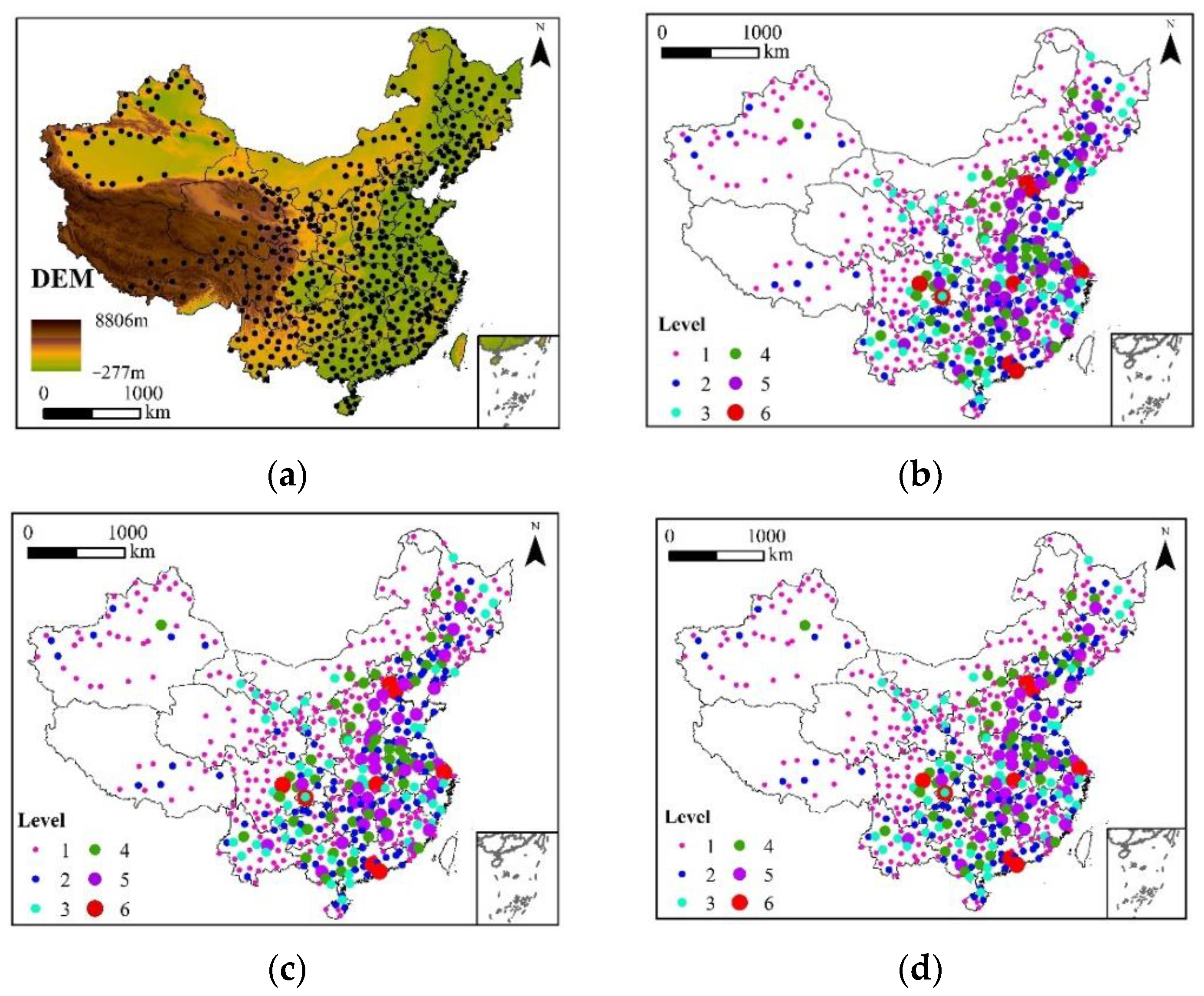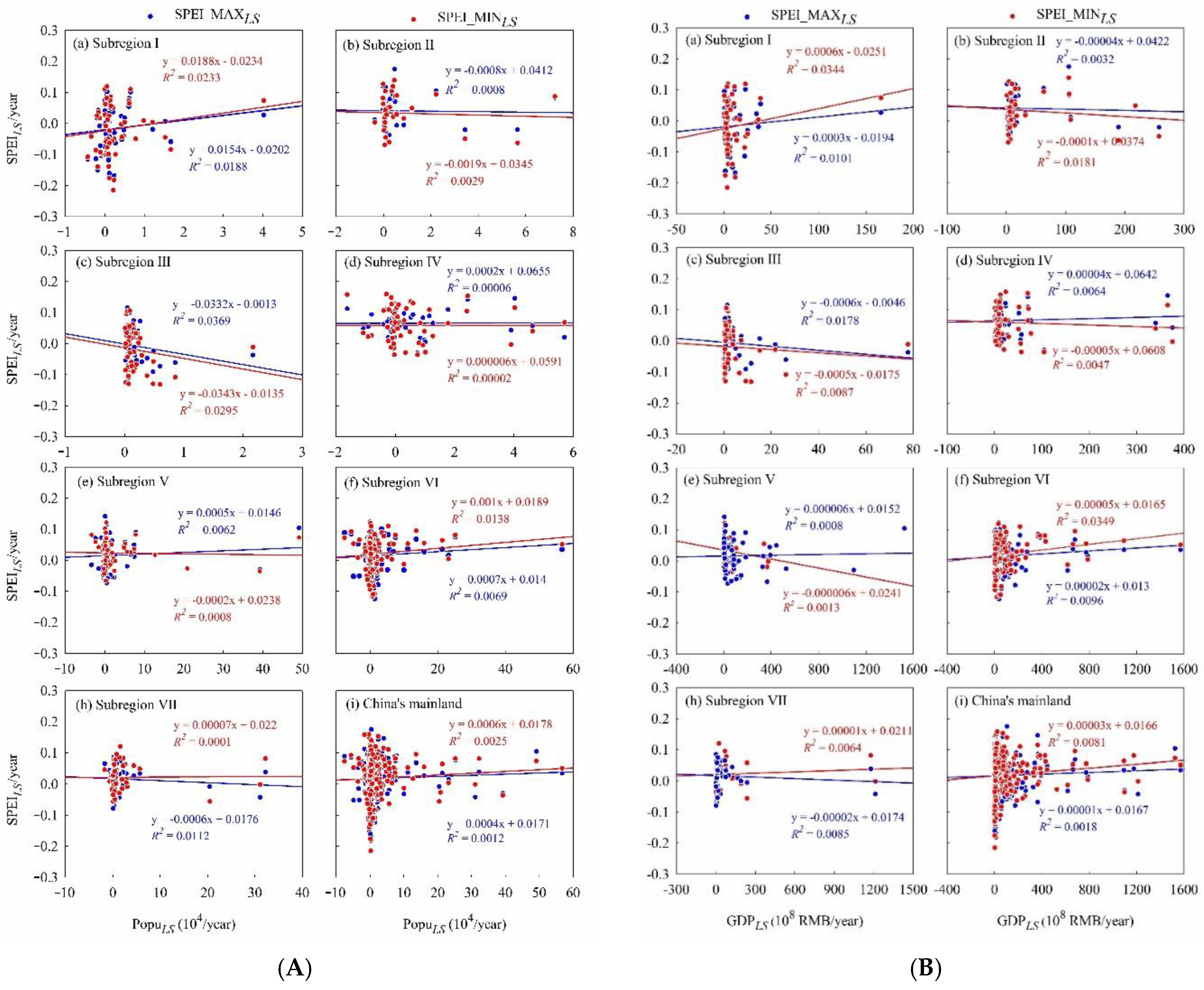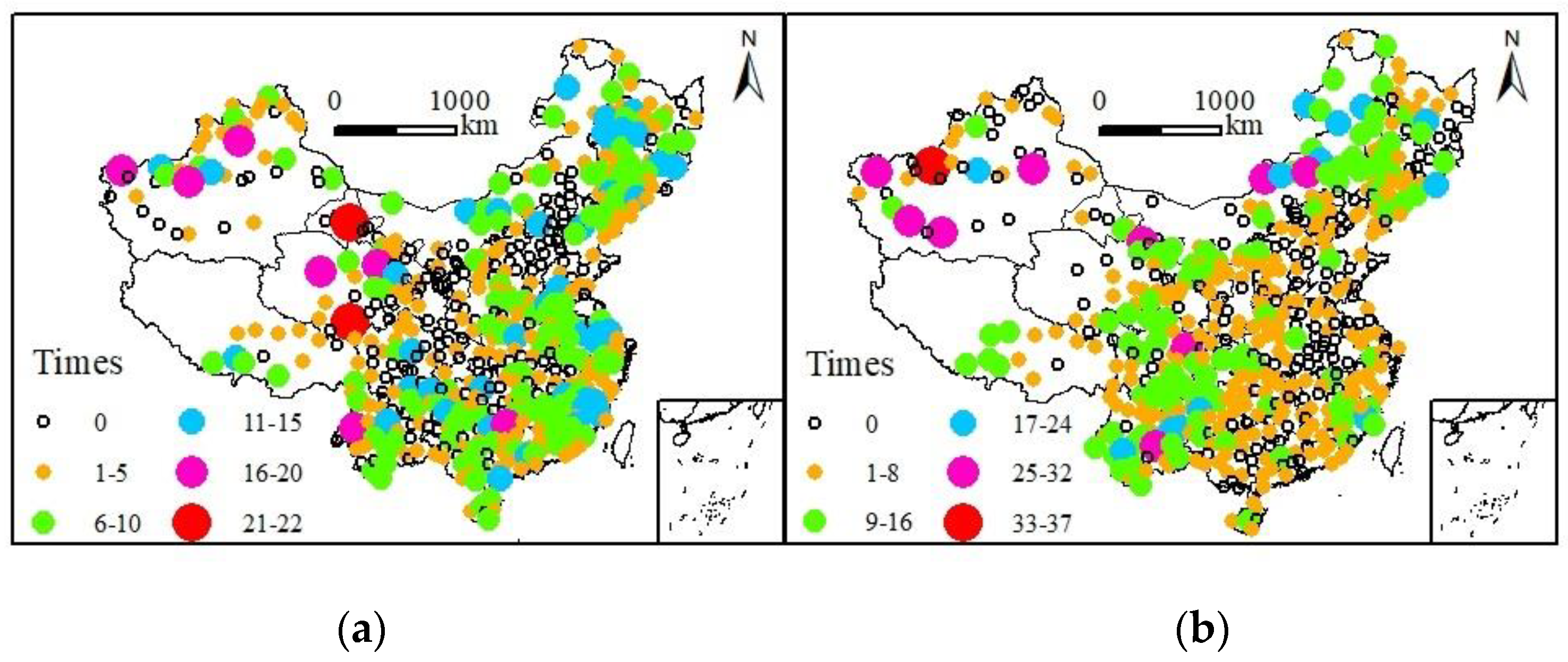Impacts of Different Socioeconomic Development Levels on Extremely Wet/Dry Events in Mainland China
Abstract
1. Introduction
2. Materials and Methods
2.1. Study Area
2.2. Data Collection
2.3. Computation of SPEI
2.4. Linear Slope Estimation
3. Results
3.1. The Spatial–Temporal Variations of Population and GDP at Different SDLs
3.2. The Temporal Variations of SPEI_MAX and SPEI_MIN
3.3. The Spatial Distribution of SPEILS, SPEI_MAXLS, and SPEI_MINLS
3.4. Relationship between PopuLS, GDPLS, SPEI_MAXLS, and SPEI_MINLS
3.4.1. LSs of Socioeconomic Dry/Wet Indices in Different SDLs
3.4.2. Relationship between PopuLS, GDPLS, and SPEI_MAXLS and SPEI_MINLS
3.5. The Variations of LSs for Dry Events at Different SDLs
3.6. The Occurrence of Extremely Wet/Dry Events
3.6.1. Spatial Distribution of Occurrence Time of Extremely Wet/Dry Events
3.6.2. Occurrence of Extremely Wet/Dry Events at Different SDLs
4. Discussion
5. Conclusions
Supplementary Materials
Author Contributions
Funding
Institutional Review Board Statement
Informed Consent Statement
Data Availability Statement
Acknowledgments
Conflicts of Interest
References
- Stegall, S.T.; Kunkel, K.E. Monthly Extreme Temperature Trends in CMIP5 Hindcast/Prediction Simulations, 1981–2010 and 2006–35. J. Appl. Meteorol. Climatol. 2017, 56, 1141–1154. [Google Scholar] [CrossRef]
- Alexander, L.V.; Arblaster, J.M. Historical and projected trends in temperature and precipitation extremes in Australia in observations and CMIP5. Weather Clim. Extrem. 2017, 15, 34–56. [Google Scholar] [CrossRef]
- Smith, K.; Morton, M.; Rico, D.; Mohamad Abadi, A.; Luna, I.; Livneh, B.; Munoz-Arriola, F. Hydroclimatology of Extreme Drought and Flood Events in the Northern High Plains, U.S.; Fall Meeting 2014; Abstract Id. H23N-1089; American Geophysical Union: Washington, DC, USA, 2014. [Google Scholar]
- Cook, E.R.; Seager, R.; Cane, M.A.; Stahle, D.W. North American drought: Reconstructions, causes, and consequences. Earth-Sci. Rev. 2007, 81, 93–134. [Google Scholar] [CrossRef]
- Komori, D.; Nakamura, S.; Kiguchi, M.; Nishijima, A.; Yamazaki, D.; Suzuki, S.; Kawasaki, A.; Oki, K.; Oki, T. Characteristics of the 2011 Chao Phraya River flood in Central Thailand. Hydrol. Res. Lett. 2012, 6, 41–46. [Google Scholar] [CrossRef]
- Sena, J.A.; Beser de Deus, L.A.; Freitas, M.A.V.; Costa, L. Extreme Events of Droughts and Floods in Amazonia: 2005 and 2009. Water Resour. Manag. 2012, 26, 1665–1676. [Google Scholar] [CrossRef]
- Modarres, R.; Sarhadi, A.; Burn, D.H. Changes of extreme drought and flood events in Iran. Glob. Planet. Chang. 2016, 144, 67–81. [Google Scholar] [CrossRef]
- Jayadas, A.; Ambujam, N.K. A quantitative assessment of vulnerability of farming communities to extreme precipitation events in Lower Vellar River sub-basin, India. Environ. Dev. Sustain. 2022. [Google Scholar] [CrossRef]
- Jongman, B.; Hochrainer-Stigler, S.; Feyen, L.; Aerts, J.C.J.H.; Mechler, R.; Botzen, W.J.W.; Bouwer, L.M.; Pflug, G.; Rojas, R.; Ward, P.J. Increasing stress on disaster-risk finance due to large floods. Nat. Clim. Chang. 2014, 4, 264–268. [Google Scholar] [CrossRef]
- Jonkman, S.N. Global Perspectives on Loss of Human Life Caused by Floods. Nat. Hazards 2005, 34, 151–175. [Google Scholar] [CrossRef]
- Spinoni, J.; Barbosa, P.; De Jager, A.; McCormick, N.; Naumann, G.; Vogt, J.V.; Magni, D.; Masante, D.; Mazzeschi, M. A new global database of meteorological drought events from 1951 to 2016. J. Hydrol. Reg. Stud. 2019, 22, 100593. [Google Scholar] [CrossRef]
- Shiru, M.S.; Shahid, S.; Chung, E.-S.; Alias, N. Changing characteristics of meteorological droughts in Nigeria during 1901–2010. Atmospheric Res. 2019, 223, 60–73. [Google Scholar] [CrossRef]
- Liu, Y.; Cai, W.; Lin, X.; Li, Z. Increased extreme swings of Atlantic intertropical convergence zone in a warming climate. Nat. Clim. Chang. 2022, 12, 828–833. [Google Scholar] [CrossRef]
- Collins, M.J. Evidence for Changing Flood Risk in New England Since the Late 20th Century. JAWRA J. Am. Water Resour. Assoc. 2009, 45, 279–290. [Google Scholar] [CrossRef]
- Daksiya, V.; Mandapaka, P.V.; Lo, E.Y.M. Effect of climate change and urbanisation on flood protection decision-making. J. Flood Risk Manag. 2021, 14, e12681. [Google Scholar] [CrossRef]
- Farhidi, F.; Madani, K.; Crichton, R. Have Extreme Events Awakened Us? Sustainability 2022, 14, 7417. [Google Scholar] [CrossRef]
- Brunner, M.I.; Slater, L.; Tallaksen, L.M.; Clark, M. Challenges in modeling and predicting floods and droughts: A review. WIREs Water 2021, 8, e1520. [Google Scholar] [CrossRef]
- Wang, W.; Chen, X.; Shi, P.; van Gelder, P.H.A.J.M. Detecting changes in extreme precipitation and extreme streamflow in the Dongjiang River Basin in southern China. Hydrol. Earth Syst. Sci. 2008, 12, 207–221. [Google Scholar] [CrossRef]
- Duan, W.; He, B.; Nover, D.; Fan, J.; Yang, G.; Chen, W.; Meng, H.; Liu, C. Floods and associated socioeconomic damages in China over the last century. Nat. Hazards 2016, 82, 401–413. [Google Scholar] [CrossRef]
- Zhao, X.; Li, H.; Qi, Y. Are Chinese Cities Prepared to Manage the Risks of Extreme Weather Events? Evidence from the 2021.07.20 Zhengzhou Flood in Henan Province 2022. Available online: https://ssrn.com/abstract=4043303 (accessed on 29 September 2022). [CrossRef]
- Fan, J.; Liu, B.; Ming, X.; Sun, Y.; Qin, L. The amplification effect of unreasonable human behaviours on natural disasters. Humanit. Soc. Sci. Commun. 2022, 9, 322. [Google Scholar] [CrossRef]
- Yang, J.; Gong, D.; Wang, W.; Hu, M.; Mao, R. Extreme drought event of 2009/2010 over southwestern China. Meteorol. Atmospheric Phys. 2012, 115, 173–184. [Google Scholar] [CrossRef]
- Mallapaty, S. China’s extreme weather challenges scientists trying to study it. Nature 2022, 609, 888. [Google Scholar] [CrossRef] [PubMed]
- Beguería, S.; Vicente-Serrano, S.M.; Reig, F.; Latorre, B. Standardized precipitation evapotranspiration index (SPEI) revisited: Parameter fitting, evapotranspiration models, tools, datasets and drought monitoring. Int. J. Climatol. 2014, 34, 3001–3023. [Google Scholar] [CrossRef]
- Chamberlin, G. Gross domestic product, real income and economic welfare. Econ. Labour Mark. Rev. 2011, 5, 5–25. [Google Scholar] [CrossRef][Green Version]
- Yao, N.; Li, Y.; Lei, T.; Peng, L. Drought evolution, severity and trends in mainland China over 1961–2013. Sci. Total Environ. 2018, 616–617, 73–89. [Google Scholar] [CrossRef] [PubMed]
- Yao, N.; Li, Y.; Li, N.; Yang, D.; Ayantobo, O.O. Bias correction of precipitation data and its effects on aridity and drought assessment in China over 1961–2015. Sci. Total Environ. 2018, 639, 1015–1027. [Google Scholar] [CrossRef]
- Liu, L.; Wang, Z. The development and application practice of wind–solar energy hybrid generation systems in China. Renew. Sustain. Energy Rev. 2009, 13, 1504–1512. [Google Scholar] [CrossRef]
- Ayugi, B.; Ngoma, H.; Babaousmail, H.; Karim, R.; Iyakaremye, V.; Lim Kam Sian, K.T.C.; Ongoma, V. Evaluation and projection of mean surface temperature using CMIP6 models over East Africa. J. Afr. Earth Sci. 2021, 181, 104226. [Google Scholar] [CrossRef]
- Polong, F.; Chen, H.; Sun, S.; Ongoma, V. Temporal and spatial evolution of the standard precipitation evapotranspiration index (SPEI) in the Tana River Basin, Kenya. Theor. Appl. Climatol. 2019, 138, 777–792. [Google Scholar] [CrossRef]
- Ojara, M.A.; Yunsheng, L.; Babaousmail, H.; Sempa, A.K.; Ayugi, B.; Ogwang, B.A. Evaluation of Drought, Wet Events, and Climate Variability Impacts on Maize Crop Yields in East Africa during 1981–2017. Int. J. Plant Prod. 2022, 16, 41–62. [Google Scholar] [CrossRef]
- Allan, R.; Pereira, L.; Smith, M. Crop Evapotranspiration-Guidelines for Computing Crop Water Requirements; FAO Irrigation and Drainage Paper 56; Food and Agriculture Organization: Rome, Italy, 1998; Volume 56. [Google Scholar]
- Chen, Y.; Li, Y.; Qi, D. Analysis on effect of south asia high on mid-summer extreme drought and flood in Sichuan-Chongqing region. J. Trop. Meteorol. 2014, 20, 163–172. [Google Scholar] [CrossRef]
- Vicente-Serrano, S.M.; Beguería, S.; López-Moreno, J.I. A Multiscalar Drought Index Sensitive to Global Warming: The Standardized Precipitation Evapotranspiration Index. J. Clim. 2010, 23, 1696–1718. [Google Scholar] [CrossRef]
- Singh, V.P.; Guo, H.; Yu, F.X. Parameter estimation for 3-parameter log-logistic distribution (LLD3) by Pome. Stoch. Hydrol. Hydraul. 1993, 7, 163–177. [Google Scholar] [CrossRef]
- Zhao, X.; Xia, H.; Liu, B.; Jiao, W. Spatiotemporal Comparison of Drought in Shaanxi–Gansu–Ningxia from 2003 to 2020 Using Various Drought Indices in Google Earth Engine. Remote Sens. 2022, 14, 1570. [Google Scholar] [CrossRef]
- Li, L.; Yao, N.; Liu, D.L.; Song, S.; Lin, H.; Chen, X.; Li, Y. Historical and future projected frequency of extreme precipitation indicators using the optimized cumulative distribution functions in China. J. Hydrol. 2019, 579, 124170. [Google Scholar] [CrossRef]
- Lu, E.; Cai, W.; Jiang, Z.; Zhang, Q.; Zhang, C.; Higgins, R.W.; Halpert, M.S. The day-to-day monitoring of the 2011 severe drought in China. Clim. Dyn. 2014, 43, 1–9. [Google Scholar] [CrossRef]
- Li, C.; Shen, D.; Dong, J.; Yin, J.; Zhao, J.; Xue, D. Monitoring of urban heat island in Shanghai, China, from 1981 to 2010 with satellite data. Arab. J. Geosci. 2014, 7, 3961–3971. [Google Scholar] [CrossRef]
- Jaqaman, H.; Mekjian, A.Z.; Zamick, L. Nuclear condensation. Phys. Rev. C 1983, 27, 2782–2791. [Google Scholar] [CrossRef]
- Yin, S.; Li, W.; Chen, D.; Jeong, J.-H.; Guo, W. Diurnal variations of summer precipitation in the Beijing area and the possible effect of topography and urbanization. Adv. Atmos. Sci. 2011, 28, 725–734. [Google Scholar] [CrossRef]
- Zheng, Z.; Gao, H.; Wang, Z.W.; Li, Q.C. Analysis on Spatial Distribution of Precipitation in Beijing and Its City Effect. Plateau Meteorol. 2014, 33, 522–529. (In Chinese) [Google Scholar] [CrossRef]
- Song, X.; Zhang, J.; He, R.; Zou, X.; Zhang, C. Urban flood and waterlogging and causes analysis in Beijing. Advances in Water Science. 2019, 30, 153–165. (In Chinese) [Google Scholar] [CrossRef]
- Zhang, J.; Wang, Y.; He, R.; Hu, Q.; Song, X. Discussion on the urban flood and waterlogging and causes analysis in China. Adv. Water Sci. 2016, 27, 485–491. [Google Scholar] [CrossRef]
- Yang, G.; Ying, S. Evaluating the Demand of Investment and Financing in Rural Infrastructure Construction in Jiangsu Province. Affect. Comput. Intell. Interact. 2012, 137, 891–901. [Google Scholar] [CrossRef]
- Feng, H.; Zhang, M. Global land moisture trends: Drier in dry and wetter in wet over land. Sci. Rep. 2016, 5, 18018. [Google Scholar] [CrossRef] [PubMed]
- Chou, C.; Neelin, J.D.; Chen, C.; Tu, J. Evaluating the “Rich-Get-Richer” Mechanism in Tropical Precipitation Change under Global Warming. J. Clim. 2009, 22, 1982–2005. [Google Scholar] [CrossRef]
- Chen, X.; Li, Y.; Yao, N.; Liu, D.L.; Liu, Q.; Song, X.; Liu, F.; Pulatov, B.; Meng, Q.; Feng, P. Projected dry/wet regimes in China using SPEI under four SSP-RCPs based on statistically downscaled CMIP6 data. Int. J. Climatol. 2022, 1–28. [Google Scholar] [CrossRef]
- Javed, T.; Li, Y.; Feng, K.; Ayantobo, O.O.; Ahmad, S.; Chen, X.; Rashid, S.; Suon, S. Monitoring responses of vegetation phenology and productivity to extreme climatic conditions using remote sensing across different sub-regions of China. Environ. Sci. Pollut. Res. 2021, 28, 3644–3659. [Google Scholar] [CrossRef]
- Sillmann, J.; Stjern, C.W.; Myhre, G.; Samset, B.H.; Hodnebrog, Ø.; Andrews, T.; Boucher, O.; Faluvegi, G.; Forster, P.; Kasoar, M.R.; et al. Extreme wet and dry conditions affected differently by greenhouse gases and aerosols. Npj Clim. Atmospheric Sci. 2019, 2, 1–7. [Google Scholar] [CrossRef]
- Bucchignani, E.; Zollo, A.L.; Cattaneo, L.; Montesarchio, M.; Mercogliano, P. Extreme weather events over China: Assessment of COSMO-CLM simulations and future scenarios. Int. J. Climatol. 2017, 37, 1578–1594. [Google Scholar] [CrossRef]
- Wang, X. Managing Land Carrying Capacity: Key to Achieving Sustainable Production Systems for Food Security. Land 2022, 11, 484. [Google Scholar] [CrossRef]
- Gerdener, H.; Kusche, J.; Schulze, K.; Ghazaryan, G.; Dubovyk, O. Revising precipitation—Water storages—Vegetation signatures with GRACE-based data assimilation. J. Hydrol. 2022, 612, 128096. [Google Scholar] [CrossRef]










| SDL | Classified by Population (×104) | Classified by GDP (×108 RMB) | Classified by Both Population (×104) and GDP (×108 RMB) |
|---|---|---|---|
| 1 | <50 | <100 | Population < 50 and GDP < 100 |
| 2 | 50–100 | 100–400 | 50 ≤ Population < 100 and 100 ≤ GDP < 400 |
| 3 | 100–300 | 400–1000 | 100 ≤ Population < 300 and 400 ≤ GDP < 1000 |
| 4 | 300–500 | 1000–2000 | 300 ≤ Population < 500 and 1000 ≤ GDP < 2000 |
| 5 | 500–1000 | 2000–10,000 | 500 ≤ Population < 1000 and 2000 ≤ GDP < 10,000 |
| 6 | ≥1000 | ≥10,000 | Population ≥ 1000 and GDP ≥ 10,000 |
| SPEI Range | Severity Level | SPEI Range | Severity Level |
|---|---|---|---|
| SPEI ≥ 2 | Extremely wet | −1.0 < SPEI ≤ −0.5 | Mild drought |
| 1.5 ≤ SPEI < 2 | Severely wet | −1.5 < SPEI ≤ −1.0 | Moderate drought |
| 1.0 ≤ SPEI < 1.5 | Moderately wet | −2.0 < SPEI ≤ −1.5 | Severe drought |
| 0.5 ≤ SPEI < 1.0 | Mildly wet | SPEI ≤ −2.0 | Extreme drought |
| −0.5 < SPEI < 0.5 | Normal |
Publisher’s Note: MDPI stays neutral with regard to jurisdictional claims in published maps and institutional affiliations. |
© 2022 by the authors. Licensee MDPI, Basel, Switzerland. This article is an open access article distributed under the terms and conditions of the Creative Commons Attribution (CC BY) license (https://creativecommons.org/licenses/by/4.0/).
Share and Cite
Zhang, Q.; Li, Y.; Hu, Q.; Yao, N.; Song, X.; Liu, F.; Pulatov, B.; Meng, Q.; Feng, P. Impacts of Different Socioeconomic Development Levels on Extremely Wet/Dry Events in Mainland China. Water 2022, 14, 3950. https://doi.org/10.3390/w14233950
Zhang Q, Li Y, Hu Q, Yao N, Song X, Liu F, Pulatov B, Meng Q, Feng P. Impacts of Different Socioeconomic Development Levels on Extremely Wet/Dry Events in Mainland China. Water. 2022; 14(23):3950. https://doi.org/10.3390/w14233950
Chicago/Turabian StyleZhang, Qingfeng, Yi Li, Qiaoyu Hu, Ning Yao, Xiaoyan Song, Fenggui Liu, Bakhtiyor Pulatov, Qingtao Meng, and Puyu Feng. 2022. "Impacts of Different Socioeconomic Development Levels on Extremely Wet/Dry Events in Mainland China" Water 14, no. 23: 3950. https://doi.org/10.3390/w14233950
APA StyleZhang, Q., Li, Y., Hu, Q., Yao, N., Song, X., Liu, F., Pulatov, B., Meng, Q., & Feng, P. (2022). Impacts of Different Socioeconomic Development Levels on Extremely Wet/Dry Events in Mainland China. Water, 14(23), 3950. https://doi.org/10.3390/w14233950










